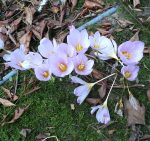 Native to parts of Turkey, Syria and Lebanon, this perennial corm is a member of the iris family, Iridaceae, that also includes gladiol a,freesia, and crocosmia. Plants produce goblet-shaped pale lilac flowers with yellow throat and creamy-yellow stamens in autumn or early winter. The grass-like leaves appear after the flowers and persist to replenish the corm. Photo Credit: Meneerke bloem Wikipedia
Native to parts of Turkey, Syria and Lebanon, this perennial corm is a member of the iris family, Iridaceae, that also includes gladiol a,freesia, and crocosmia. Plants produce goblet-shaped pale lilac flowers with yellow throat and creamy-yellow stamens in autumn or early winter. The grass-like leaves appear after the flowers and persist to replenish the corm. Photo Credit: Meneerke bloem Wikipedia
There are 15 or more kinds of crocuses in the Holy Land. Four of these grow in alpine and subalpine regions and rocky places in the mountains of Lebanon (as well as elsewhere) which is a significant factor when considering Song of Song 6:4. In this passage a lover is comparing his beloved to cities but some authorities think that flowers are actually meant. Four flowers are suggested for the city Tirzah due to their presence in the area that inspired the writing of the passage: Crocus cancellatus var. damascenus, C. hyemalis, C. vitellinus, and C. zonatus (see entries for these species for further information)
Song of Songs 6:4 (NIV)
“You are as beautiful as Tirzah, my darling, as lovely as Jerusalem, as majestic as troops with banners.”
Kotschy’s Crocus likes full sun to partial shade and average to lean, medium moist, well-drained soil in USDA Hardiness Zones 6-9 and is drought tolerant. Propagation is by seed or division but plants are rampant self-seeders which sometimes results in undersized flowers. The plants are generally healthy but are susceptible to damage by mice, voles, and squirrels and viral infection that can cause undersized and deformed flowers. When well grown, these crocuses are attractive in beds, borders, and gravel, rock, and container gardens and add color when few other plants are blooming.
The genus name, Crocus, is from the Greek word κρόκος, krokos meaning thread and refers to the appearance of the stigmas. The specific epithet, kotschyanus, honors Theodor Kotschy (1801-1887), Austrian botanist, plant-collector and traveler in North Africa and western Asia. Photo Credit Meneerke-bloem-Wikipedia